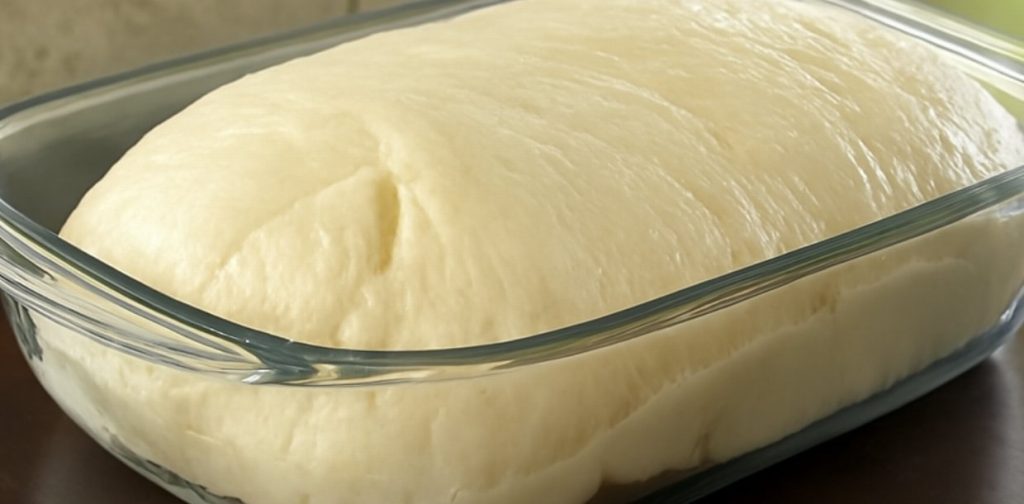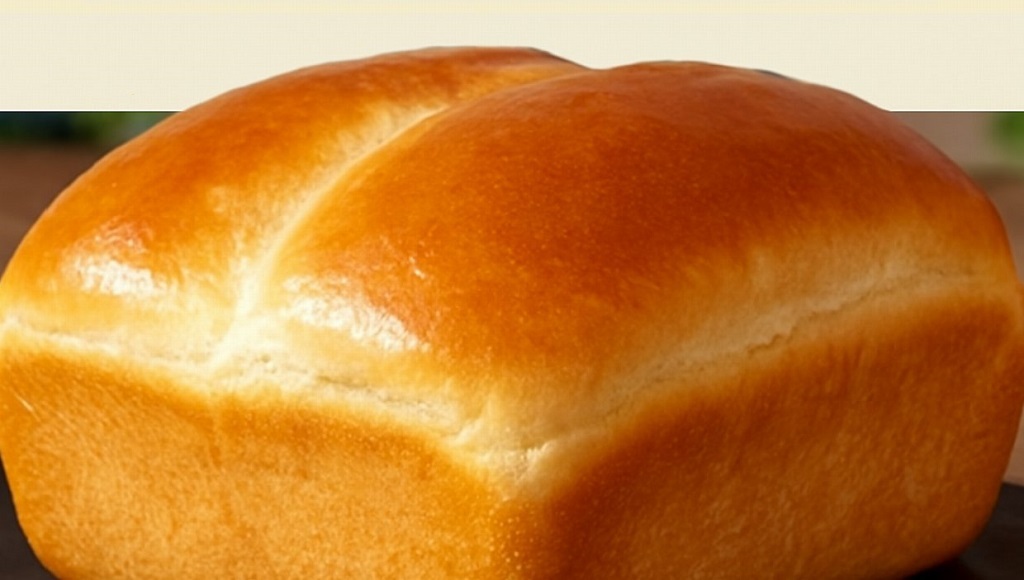This soft homemade bread dough recipe is my not so secret weapon in the kitchen. As a chef who thrives on simplicity and soul warming results, this dough delivers every single time. It’s fluffy like a cloud, golden on the outside, tender on the inside and yes, it smells just as dreamy as it tastes.
Whether you’re crafting a classic loaf, soft dinner rolls, or rustic artisan style buns, this recipe is your blank canvas. With a gentle knead and the right rise, you’ll create homemade bread so good, you’ll forget store bought even exists. Trust me, once you bake with this dough, you’ll never look back.
“A simple bread made with care will always outshine the fanciest pastry.” – @DailyDoughLove
Why This Bread Dough Is So Loved
- Only 6 ingredients – All pantry staples, no preservatives or additives.
- Super fluffy interior – Thanks to the perfect ratio of flour to water and a warm proof.
- Versatile and reliable – Use it for sandwich bread, rolls, pizza crust, or even cinnamon buns.
- Beginner friendly – No bread machine needed, just a bowl and your hands.
- Freezer ready – Prep a batch and freeze shaped loaves for later bakes.
Pair this warm bread with hearty vegetable soup or slather it in jam beside a slice of Cheesecake Factory style bread for the ultimate homemade experience.
Ingredients
- 4 cups all purpose flour (500g)
- 2 teaspoons salt (10g)
- 2 teaspoons sugar (10g)
- 1 packet active dry yeast (7g)
- 1 and 1/2 cups warm water (355ml)
- 2 tablespoons olive oil (30ml)
Step by Step Instructions
1: Activate the Yeast
- In a large bowl, mix the warm water, sugar, and yeast.
- Let it sit for 5 to 10 minutes until it becomes frothy and bubbly.
2: Make the Dough
- Add flour, salt, and olive oil to the bowl.
- Mix until a sticky dough forms.
3: Knead to Smoothness
- Transfer the dough to a floured surface.
- Knead for 5 to 7 minutes until the dough is soft, stretchy, and smooth.
4: First Rise
- Place dough in a greased bowl and cover with a towel.
- Let it rise in a warm place for 1 to 1.5 hours or until doubled in size.
5: Shape the Dough
- Punch down the risen dough to release air.
- Divide and shape into loaves or rolls as desired.
6: Second Rise
- Place the shaped dough on a parchment lined or greased baking tray.
- Cover and let rise again for 30 to 45 minutes.
7: Bake
- Preheat oven to 375°F (190°C).
- Bake for 25 to 30 minutes until golden brown.
- Let cool on a wire rack before slicing.
“Warm bread, fresh from the oven, has the power to turn an ordinary day into something special.” – @OvenWhispers

Chef’s Tips for Fluffiest Results
- Use a thermometer: Water should be around 110°F (43°C) to activate yeast properly.
- Let it rise slowly: Proofing in a slightly cooler place for longer can improve texture and flavor.
- Brush with melted butter: After baking, for a soft, shiny crust.
- Add ins: Fold in herbs, cheese, or chopped olives during shaping for extra flavor.
Looking for more bakery style bakes? Try our milk brioche recipe or whip up buttery fluffy milk buns that melt in your mouth.
Creative Uses for This Bread Dough
One Dough, Endless Possibilities
This base dough isn’t just for sandwich bread. Here are some of my favorite ways to remix this versatile recipe:
- Dinner rolls: Shape into 12 equal balls and bake in a buttered pan.
- Garlic knots: Roll into ropes, tie into knots, brush with garlic butter, and bake.
- Mini pizza crusts: Roll small portions into flat rounds, pre bake slightly, then top with sauce and cheese.
- Stuffed buns: Add cooked fillings like cheese, sausage, or veggies before baking.
If you love versatile doughs, don’t miss our famous crazy dough recipe perfect for everything from pizza to cinnamon rolls!
How to Get the Best Rise from Your Dough
Mastering the First and Second Rise
Getting a perfectly risen dough is what transforms a good bread into an unforgettable one. As a chef, this part of the process always excites me watching dough grow and puff up like a soft pillow is pure kitchen magic. Here’s how I consistently get cloud like texture and volume, every single time:
- Warm environment is key: Aim for a room temperature between 75°F to 80°F (24°C to 27°C). Too cold and the yeast slows down, too hot and it dies.
- Use your oven as a proof box: Preheat your oven to the lowest setting for 2 minutes, then turn it off. Place the dough inside to rise works like a charm!
- Don’t rush the second rise: This final proof gives your bread that airy texture and helps prevent dense centers.
- Look for visual cues: Dough should nearly double in size and bounce back slowly when poked with a finger.
Want to boost your bread baking even further? Try our fluffy blender cake or cloud soft condensed milk bread both depend on a well risen base to shine.
“Dough is a living thing treat it gently, give it warmth, and it’ll reward you with softness and flavor.” – @RiseAndShineBakery
Signs of Overproofing and Underproofing
It’s a delicate balance. A slightly underproofed dough can still bake well, but overproofed dough may collapse. Here’s how to tell the difference before it hits the oven:
- Underproofed: Tight, uneven crumb, less rise in the oven, dense or gummy texture.
- Overproofed: Weak structure, dough may collapse, large, uneven air pockets and lack of oven spring.
- Just right: Evenly risen, slightly domed top, with a smooth surface and springy feel.
If you’re ever in doubt, go for a gentle “poke test.” Lightly press a finger into the dough if it springs back slowly and leaves a slight indent, it’s ready to bake!
Baking Enhancements and Optional Toppings
Simple Upgrades to Elevate Your Bread
Once you’ve mastered this base recipe, the fun begins. You can turn this dough into everything from golden sandwich loaves to artisan rolls just by switching up your finishing touches. Here are my favorite ways to take this recipe to bakery level:
- Shiny top: Brush with egg wash (1 egg + 1 tbsp water) before baking for a glossy crust.
- Soft top: Brush with melted butter right after baking for a velvety finish.
- Crunchy top: Sprinkle with sesame seeds, poppy seeds, or everything seasoning just before baking.
- Sweet touch: Dust with cinnamon sugar if making breakfast rolls or dessert style buns.
Want another unique bread recipe to try next? Our cheese potato bread has a crispy crust and a cheesy core that’s unforgettable.
“The right topping can turn a simple loaf into a signature bake.” – @CrustCrafterChef
Shape Variations for Special Occasions
This dough is a dream to shape soft, elastic, and pliable. Whether you’re prepping for a family dinner, brunch with friends, or just feel like getting creative, here are fun shapes to try with your bread dough:
- Braided loaf: Divide dough into three strands, braid like hair, and tuck the ends under before baking.
- Pull apart rolls: Roll into small balls and nestle them into a round cake pan perfect for parties.
- Twisted knots: Roll into ropes and twist into garlic knots or herb spirals.
- Mini loaves: Divide into four equal parts and shape into smaller loaves great for gifting or portion control.
If shaping bread brings you joy, you’ll also appreciate our beautiful pineapple quick bread a moist and tropical spin on traditional loaves.
“The beauty of homemade dough is that every shape tells a different story.” – @ShapeYourBakes
Storage and Freezing Instructions
- At room temperature: Store in a bread box or covered container for 2 to 3 days.
- In the fridge: Keeps well up to 1 week. Just warm slightly before serving.
- Freezer: Wrap shaped unbaked dough or baked loaves in plastic and foil. Freeze up to 2 months.
To thaw frozen dough, place it in the fridge overnight and let it rise at room temperature before baking.
Serving Suggestions
- With soup: Serve warm rolls with cowboy soup or vegetable soup.
- As breakfast toast: Top slices with almond butter, jam, or eggs.
- Make a sandwich: Use for your favorite meats, cheeses, or grilled veggies.
Nutrition Facts (Per Serving – Approx. 1 slice from 12 servings)
- Calories: 200
- Carbohydrates: 36g
- Protein: 5g
- Fat: 4g
- Sugar: 1g
More Bread Recipes to Explore
- 10 Minute Skillet Bread
- Cheese Potato Bread in a Pan
- Vanilla Pound Cake
- Fluffy Homemade Doughnuts
- Soft Milk Brioche Bread
Frequently Asked Questions About Soft Homemade Bread Dough
Can I make this dough ahead of time?
Absolutely! After the first rise, you can cover the dough tightly and refrigerate it for up to 24 hours. Let it come to room temperature before shaping and doing the second rise. You can also freeze the dough (shaped or unshaped) for future baking adventures.
What’s the best flour to use for fluffy bread?
All purpose flour works great and gives a soft, fluffy crumb. If you prefer more chew and structure, you can replace half with bread flour. For a healthier option, try substituting up to 25% with whole wheat flour, but expect a denser result.
Why didn’t my dough rise?
This usually happens due to inactive yeast or water that’s too hot or too cold. Make sure your water is between 100°F and 110°F (38°C to 43°C) and that your yeast hasn’t expired. Also, let the dough rest in a warm, draft free space for the best rise.
Can I add herbs or cheese to the dough?
Yes! Fold in chopped fresh herbs (like rosemary or basil), shredded cheese, or even minced garlic during the mixing step. Just keep the mix-ins to about 1/2 cup total to avoid affecting the dough’s structure.
Is this dough suitable for pizza or flatbreads?
Absolutely. It makes an excellent pizza crust just roll out and top after the first rise. For flatbreads, divide and roll thin, then cook in a hot skillet or oven. You can even brush with garlic butter or sprinkle za’atar for a gourmet twist.
Can I use this dough in a bread machine?
Yes! Add the ingredients to your machine in the order recommended by the manufacturer (usually liquids first). Use the dough setting and proceed with shaping and baking once it’s done.
How do I get a golden crust without overbaking?
Use an egg wash or milk wash before baking for a rich golden color. Keep an eye on the bread during the last 5 minutes of baking, and tent with foil if the top is browning too quickly.
Can I make this bread gluten free?
This recipe relies on gluten for structure and rise, so it won’t turn out well with a 1:1 gluten free flour substitute. However, we recommend trying our 3 ingredient egg yogurt bread or orange blender cake for gluten free friendly options.
“Every home baker has questions just ask them. That’s how the best loaves are born.” – @BreadNerdsUnite
